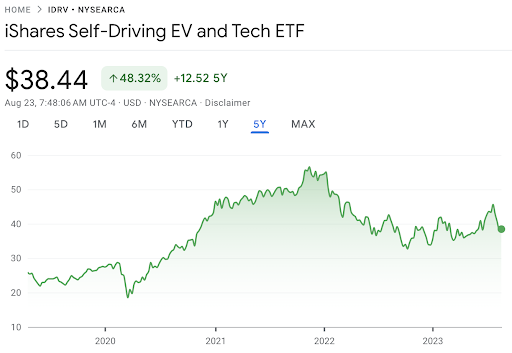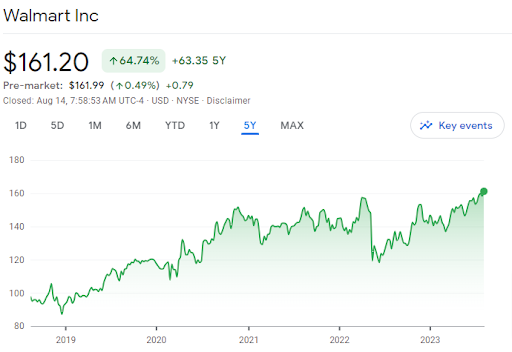Are EV ETFs a Good Investment? (5 Best ETFs, Pros & Cons)
EV ETFs hold a basket of stocks of different electric vehicle companies, car battery makers, and tech providers in the sector.
This is your chance to tap into the lucrative electric vehicle market easily and diversify your portfolio.
We’ll explore some of the most promising EV ETFs in 2023, how they work, how to invest in them, and their pros and cons.
But that’s not all.
We’ll also introduce you to another lucrative alternative asset — fine wine, and how you can easily invest in it through Vinovest.
Further reading
- Want to invest in other types of ETFs? Consider Alcohol ETFs or check out some of the Best Farmland ETFs.
- Discover other fixed-income sources like these Alternative Investment Fund Types (like mutual funds and private equity funds.)
- Find out how ETFs Differ from Mutual Funds and which one is right for you.
5 Most Attractive EV ETFs in 2023
Here are some of the best-performing EV ETFs that you could place your bets on:
- iShares Self Driving EV and Tech ETF (IDRV)
- Global X Autonomous & Electric Vehicles ETF (DRIV)
- Global X Lithium and Battery Tech ETF (LIT)
- KraneShares Electric Vehicle and Future Mobility ETF (KARS)
- SPDR S&P Kensho Smart Mobility ETF (HAIL)
1. iShares Self Driving EV and Tech ETF (IDRV)

IDRV tracks the NYSE FactSet Global Autonomous Driving and Electric Vehicle Index.
The ETF primarily focuses on investments in self-driving, electric vehicle, EV batteries and EV-related technology companies.
The fund is fairly liquid (about 38,572 shares are traded daily on average), while it also maintains a low expense ratio of 0.47% (according to Yahoo Finance.)
Its net assets are worth more than $494 million and include shares in companies like Tesla Inc., Apple, NVIDIA, and General Motors.
- 5-Year ETF Performance Chart

Source: Google Finance
- Net Assets: $494.14 million
- Expense Ratio: 0.47%
- 3-Year Daily Total Return: 7.37%
- Founded: 2019
- Fund Issuer: BlackRock (also the issuer of iShares Global Infrastructure Equity UCITS ETF)
2. Global X Autonomous & Electric Vehicles ETF (DRIV)

This ETF has almost $1 billion in net assets. Its investments are mostly in autonomous vehicles manufacturers and tech companies.
It has 73 fund holdings, electric vehicle maker companies including Tesla, and others like Toyota, General Motors, Alphabet, Intel, and Apple.
DRIV is tracking and replicating the market price and performance of the Solactive Autonomous & Electric Vehicles Index.
- 5-Year ETF Performance Chart

Source: Google Finance
- Net Assets: $954.5 million
- Expense Ratio: 0.68%
- 3-Year Daily Total Return: 14.07%
- Founded: 2018
- Fund Issuer: Mirae Asset Global Investments
3. Global X Lithium and Battery Tech ETF (LIT)

This is one of the oldest ETFs in the electric car industry.
It was founded in 2010 with the goal of investing in EV batteries manufacturers and lithium mining operations. These are vital for producing batteries for the EV and other industries.
This electric vehicle ETF also has the largest net asset pool, with over $4.5 billion (according to Yahoo Finance.) Its top-performing companies comprise about 12% of its portfolio. These include Albemarle Corp., Naura Tech, Tesla Inc., and Panasonic.
This ETF is quite lucrative thanks to its stable returns, much higher than other EV ETFs.
- 5-Year ETF Performance Chart

Source: Google Finance
- Net Assets: $3.4 billion
- Expense Ratio: 0.75%
- 3-Year Daily Total Return: 15.46%
- Founded: 2010
- Fund Issuer: Mirae Asset Global Investments
4. KraneShares Electric Vehicle and Future Mobility ETF (KARS)

KARS presents a highly diversified portfolio with over 60 fund holdings in the electric car production, AV, lithium batteries, and microchip industries.
The index tracks the Bloomberg Electric Vehicles Index, and almost half of its holdings focus on its top-performing assets. These include Contemporary Amperex Technology (a Chinese battery manufacturer), Nio, Aptiv, Ford Motor, and Tesla.
While this fund is not as large as most other EV ETFs on this list, it offers a better ROI. It is also a great choice for investors looking for ETFs with a narrow focus on the EV industry.
- 5-Year ETF Performance Chart

Source: Google Finance
- Net Assets: $197.8 million
- Expense Ratio: 0.72%
- 3-Year Daily Total Return: 4.50%
- Founded: 2018
- Fund Issuer: China International Capital Corporation (CICC)
5. SPDR S&P Kensho Smart Mobility ETF (HAIL)

HAIL is an electric vehicle ETF with a HAIL is an electric vehicle ETF with a broader focus.
Besides investing in electric vehicle production and autonomous vehicles tech, the fund is also involved in next-gen transportation technologies, construction machinery, drones, and truck manufacturers.
The fund matches the performance of the S&P Kensho Smart Transportation Index. Some of its top fund holdings include Tesla, Li Auto, Avis Budget Group, and Veoneer.
- 5-Year ETF Performance Chart

Source: Google Finance
- Net Assets: $61.2 million
- Expense Ratio: 0.45%
- 3-Year Daily Total Return: -2.83%
- Founded: 2017
- Fund Issuer: State Street Global Advisors
Other EV ETFs to Consider Investing in
Here are a few more emerging EV ETFs worth checking out:
- Invesco Ltd Electric Vehicle Metal Commodity Strategy No K 1 ETF: Invesco Ltd has launched an ETF focusing on metal manufacturing critical for producing electric vehicles.
- Global X China Electric Vehicle and Battery ETF (2845-HK: Hong Kong Stock Exchange): This ETF was launched in early 2020 and focuses on EV and battery investments.
- Electric Vehicle Charging Infrastructure UCITS ETF (ELEC.L): This is the first ETF that focuses solely on investments in EV charging stations.
So, how do you invest in such ETFs?
How to Invest in an EV ETF

Investing in an EV ETF isn’t much different from investing in other ETF types. Just follow these steps:
- Open a brokerage account. Depending on your goals this can be a taxable, retirement, custodial, or 529 account. When choosing a brokerage service also research their fees, customer service, minimum required deposit, and other features they offer.
- Plan your ETF investment strategy. Plan carefully your asset allocation, risk tolerance, and long-term vs. short-term gains.
- Research some ETFs and choose the ones that align with your strategy. A few things to check are what index the ETF follows, the ETF’s expense ratio, and operating fees.
- Buy shares of these ETFs (similar to buying ordinary equity securities and component securities.) You can do that online, through a mobile app, or in person.
- Set up a purchasing plan. Figure out how much money you want to invest in the ETF on a regular basis.
- Plan your exit strategy. When you want to sell your shares, you should have an exit strategy in place. This way, you can minimize any fees and taxes related to your investment.
If you’re a beginner investor, you can also turn to a broker for assistance.
Now, you might be wondering if EV ETFs are a good investment option for you.
Should You Invest in EV ETFs in 2023?

To help you make a decision, we’ll show you the pros, cons, and historical performance of EV ETFs:
A. Pros of Investing in EV ETFs
These benefits makes EV ETFs a good addition to your portfolio:
- Exposure to a diverse range of EV-related industries: An EV ETF invests in several EV firms like car manufacturers, battery producers, and tech companies. This provides good portfolio diversification and protects your investment from any sharp market dips.
For instance, even if an electric vehicle maker experiences a market price drop, it’s possible that lithium battery makers won’t get affected (since they source batteries for other sectors as well)
- Increasing market size: The global electric vehicle industry is valued at $388.1 billion in 2023. It’s projected to grow exponentially to $1,103 billion in 2030 due to the increasing demand for clean energy.
B. Cons of Investing in EV ETFs
These are a few drawbacks you should be aware of before putting your money in EV ETFs:
- Unstable EV sales: EV carmakers have higher expenses than ICE (internal combustion engine) vehicle manufacturers. Thus, many EV companies still struggle to break even. However, by 2025, most EV manufacturers are projected to reduce costs and even make a 2-3% profit on EV sales.
- Industry challenges: To prosper, the sector needs a well-established EV charging station network on a global level. This is heavily dependent on policymakers and infrastructure developments.
- Overvalued stocks: While the EV industry is quickly gaining popularity due to the increased push for reduced CO2 emissions and clean energy, some stocks might get overvalued. Largely due to factors like speculative buying and limited production.
This can create a bubble that might eventually burst, leading to financial losses for investors. ETFs could shield you from such instances (since the fund invests in many different EV stocks.) But if the downfall applies across the whole sector, the ETF would also be affected.
C. Historical Performance of EV ETFs
Although the electric vehicles sector is relatively new and emerging, it proves to be a potentially attractive alternative investment class.
Top EV ETFs have fared well over the years. As per 2023 ETF.com data, the Global X Autonomous & Electric Vehicles ETF (DRIV) has returned 11.95% in the past 5 years. Similarly, Global X Lithium & Battery Tech ETF (LIT) has returned 13.84% over the same period.
This is impressive compared to Dow Jones (6.09% in the last 5 years) and S&P 500 (on average, 10.67% returns annually since its inception.)
In short:
Given the promising returns, EV ETFs would make a good addition to any investor’s portfolio. Moreover, they’re a better option than investing in individual EV stocks since they disperse the risk of individual underperforming stocks.
However, the EV sector is still in its early stages of development, profits are not secure, and how fast electric vehicles are adopted worldwide heavily depends on policymakers.
So, make sure you weigh the pros and cons and ensure it fits your investment strategy in the long run.
Not sure if you’re ready to invest in EV ETFs just yet?
Consider investing in fine wine — a more stable alternative asset that showcases great investment results and a good ROI year after year (13.6% over the past 15 years.) We’ll tell you more about why it’s a super-lucrative investment.
Diversify Your Portfolio with a Profitable Asset like Fine Wine

Fine wine is an attractive investment because the finest bottles are always in high demand and in limited supply.
This asset also has little to no correlation to the traditional stock market, making it less volatile to market fluctuations. It has outperformed the Global Equity Index for the last 15 years, even during economic downswings.
However, to make a good profit, you should know which wines to buy and when to buy and sell them.
With a wine investment platform like Vinovest, you can easily invest in the finest bottles.
But do you need to be a wine expert or part of any institutional investors’ organization to do so?
No. This United States-based company allows anyone to easily buy, store, and sell fine wines from around the world with just a few clicks.
Vinovest has a team of master sommeliers and wine experts who take care of everything for you — from sourcing, authenticating and insuring the wine to storing it in top-notch facilities and selling it at the highest possible price, so you get a good profit.
And that’s not all.
You can also ship your wine directly to your address, whether you’re located in Europe, South, or North America.
So, how do you get started on this lucrative investment?
Just follow these steps:
- Sign up on the Vinovest website.
- Answer a few questions to determine your investment style and risk appetite.
- Put a minimum of $1,000 into your account.
- Enjoy a winning wine portfolio from the comfort of your home.
And you’ll be all set to reap the lucrative investment returns wine has to offer!
Invest Beyond EV ETFs for Enviable Investment Results

EV ETFs are a good fixed income source and offer great investment growth since you can tap into the electric vehicle industry in its early stages. But this comes with a certain degree of risk.
If you want to invest in a more stable, promising alternative asset, opt for fine wine instead!
Just sign up on Vinovest and start building your wine portfolio today!



